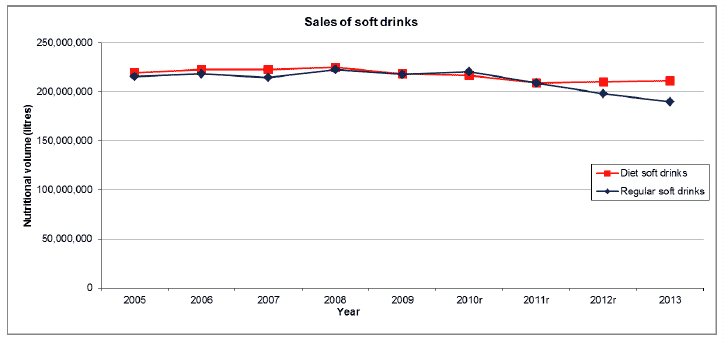Obesity Indicators 2014
This publication reports the latest available data for 16 indicators selected to monitor progress for the Prevention of Obesity Route Map. Most indicators are updated up to 2013, but for some indicators data is more or less up-to-date than this.
Volume of sales of soft drinks with added sugar
Indicator Source: Food Standards Agency Scotland (Kantar Worldpanel)
LATEST RESULTS
- The volume of regular take home soft drinks[10] (including carbonated drinks) purchased by Scottish households remained relatively stable between 2005 and 2010. Since 2010, the volume has dropped by 8.6% to 190 million litres in 2013.[11]
- 'Regular soft drinks' includes juices/fruit drinks, carbonates, squash, and others (such as flavoured milk), but excludes chilled drinks, mineral water and all diet soft drinks.
- The volume of carbonated drinks purchased by Scottish households peaked in 2008 (316 million litres) and has since declined (290 million litres in 2013).
- The calorie contribution of carbonated drinks increased from 28 kilocalories per person per day in 2005 to 32 kilocalories in 2010. This has reduced to 28 kilocalories in 2013.

ABOUT THIS INDICATOR
Desired Outcome:
Reduced consumption of high energy food and drink.
Relevant Route Map action:
Action to work with the Food Implementation Group to reduce sugar levels and portion sizes.
Geography available:
Scotland level only.
Equalities data:
Not applicable.
Rationale for including this indicator:
The aim of this indicator is to monitor the volume of sales of soft drinks with added sugar in supermarkets in Scotland. There is evidence of an association between sugar-sweetened soft drinks and prevalence of obesity and interventions in this area have been shown to be effective.
Factors influencing this indicator:
- Availability and affordability of healthy choices.
Contact
Email: Daniel Adams
There is a problem
Thanks for your feedback